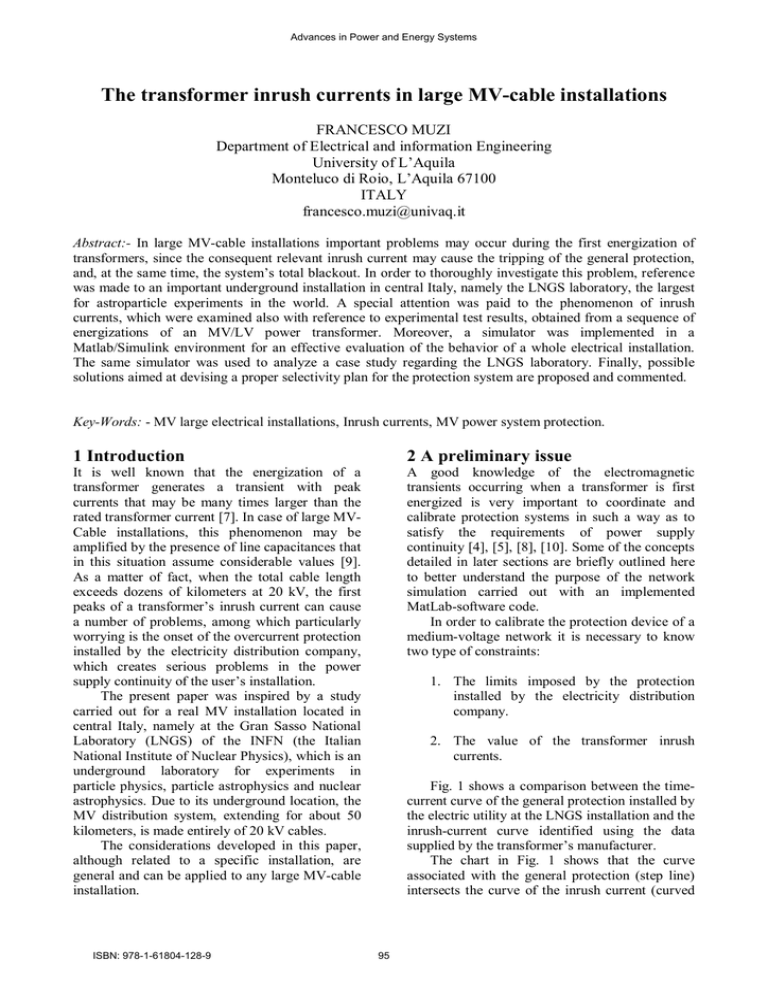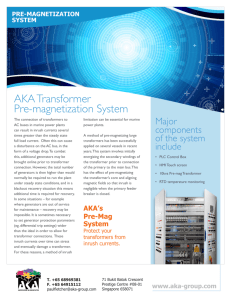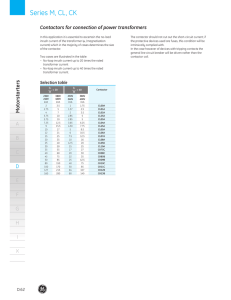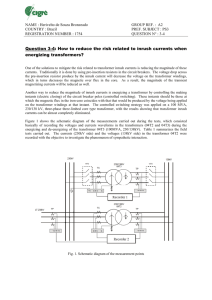The transformer inrush currents in large MV-cable installations
advertisement

Advances in Power and Energy Systems The transformer inrush currents in large MV-cable installations FRANCESCO MUZI Department of Electrical and information Engineering University of L’Aquila Monteluco di Roio, L’Aquila 67100 ITALY francesco.muzi@univaq.it Abstract:- In large MV-cable installations important problems may occur during the first energization of transformers, since the consequent relevant inrush current may cause the tripping of the general protection, and, at the same time, the system’s total blackout. In order to thoroughly investigate this problem, reference was made to an important underground installation in central Italy, namely the LNGS laboratory, the largest for astroparticle experiments in the world. A special attention was paid to the phenomenon of inrush currents, which were examined also with reference to experimental test results, obtained from a sequence of energizations of an MV/LV power transformer. Moreover, a simulator was implemented in a Matlab/Simulink environment for an effective evaluation of the behavior of a whole electrical installation. The same simulator was used to analyze a case study regarding the LNGS laboratory. Finally, possible solutions aimed at devising a proper selectivity plan for the protection system are proposed and commented. Key-Words: - MV large electrical installations, Inrush currents, MV power system protection. 1 Introduction 2 A preliminary issue It is well known that the energization of a transformer generates a transient with peak currents that may be many times larger than the rated transformer current [7]. In case of large MVCable installations, this phenomenon may be amplified by the presence of line capacitances that in this situation assume considerable values [9]. As a matter of fact, when the total cable length exceeds dozens of kilometers at 20 kV, the first peaks of a transformer’s inrush current can cause a number of problems, among which particularly worrying is the onset of the overcurrent protection installed by the electricity distribution company, which creates serious problems in the power supply continuity of the user’s installation. The present paper was inspired by a study carried out for a real MV installation located in central Italy, namely at the Gran Sasso National Laboratory (LNGS) of the INFN (the Italian National Institute of Nuclear Physics), which is an underground laboratory for experiments in particle physics, particle astrophysics and nuclear astrophysics. Due to its underground location, the MV distribution system, extending for about 50 kilometers, is made entirely of 20 kV cables. The considerations developed in this paper, although related to a specific installation, are general and can be applied to any large MV-cable installation. A good knowledge of the electromagnetic transients occurring when a transformer is first energized is very important to coordinate and calibrate protection systems in such a way as to satisfy the requirements of power supply continuity [4], [5], [8], [10]. Some of the concepts detailed in later sections are briefly outlined here to better understand the purpose of the network simulation carried out with an implemented MatLab-software code. In order to calibrate the protection device of a medium-voltage network it is necessary to know two type of constraints: ISBN: 978-1-61804-128-9 1. The limits imposed by the protection installed by the electricity distribution company. 2. The value of the transformer inrush currents. Fig. 1 shows a comparison between the timecurrent curve of the general protection installed by the electric utility at the LNGS installation and the inrush-current curve identified using the data supplied by the transformer’s manufacturer. The chart in Fig. 1 shows that the curve associated with the general protection (step line) intersects the curve of the inrush current (curved 95 Advances in Power and Energy Systems Time [s] line). In this condition, the intervention of the device puts out the entire electrical system. the rated power, that is to say, the construction features of the machine: the associated factors affect the value of the inductance to be loaded and the damping resistances. the short circuit power of the supply network: the transient will be much longer and heavier, the greater is the ratio between the power of the network and that of the transformer. the residual flux: the presence of a residual flux in the transformer’s magnetic core increases the maximum value of inrush current. the instant of energization: this is the most variable among the parameters considered, since the current’s maximum value (from 10 to 20 times the rated one) occurs when the closure of the circuit breaker coincides with the voltage zero crossing, while the minimum value (about twice the rated current), occurs when the closure of the circuit breaker coincides with the passage of the maximum value of the voltage waveform. Current [A] Fig. 1 - Time-current curve of the general circuit breaker compared with the evaluated inrush current obtained from manufacturer data. In order to estimate the value of the inrush current in the worst case, two alternatives are possible: Actually, the technical staff of the LNGS never observed tripping actions of the general protection when transformers were inserted, so it was necessary to study the inrush currents to have reliable estimates of their actual values. 3 The transformer inrush current The main phenomenon investigated in this section is the electromagnetic transient following the first transformer energization (inrush current). During the transient following the closure of the circuit breaker, a transformer acts as an unloaded inductance absorbing a very high current with a transient that can last up to 2 seconds. The value of the current is progressively reduced, thanks to the dissipative phenomena linked to the resistance of the winding conductors, until a steady-state value is reached. Both the maximum value of the inrush current and the duration of the transient depend on several parameters: ISBN: 978-1-61804-128-9 Refer to the manufacturer's data, that indicate the relationship between the maximum current peak and the rms value of the rated current of the transformer and the value of time constant. Analyze the behavior of the electrical system during an energization by means of specific software simulation. Since the evaluation performed with the data supplied by the manufacturer appeared conservative, as no circuit breaker intervention was observed on field, the second alternative was followed, that means a 20 kV network was modeled and afterwards its behavior was studied during transients caused by transformer energizations. A typical waveform of the inrush current is shown in Fig. 2 while the data by which 96 Advances in Power and Energy Systems manufacturers evaluate the inrush current of transformers are reported in Table 1. 2. Reproduction of the experimental test through the implementation of a MatlabSimulink procedure. 3. Comparison between experimental test results and those of the simulation. The rated data of the tested transformer are shown in Table 2. Table 2. Data of the tested transformer. Fig. 2. A typical waveform of the inrush current of a transformer. Rated transformer data Primary Secondary Power [kVA] 1500 Voltage [V] 11000 415 Current [A] 78.73 2086.81 Connection Delta Wye Vcc% 6% Table 1 Coefficients for the calculation of inrush currents in resin transformers. Transformer rated power [kVA] 250 400 630 1250 1600 2000 ki 12 12 11 10 9 8 Time constant τ [s] 0.22 0.25 0.30 0.35 0.40 0.45 The transformer was tested with a three-phase supply applied to the primary; the secondary was maintained unloaded. The laboratory experimentation consisted of 12 tests of 9 seconds in duration; for each test the closing angle of the Vrs line-voltage was varied of 30° and the peak values of the inrush current were recorded. Tests were carried out in a network having a 100MVA short-circuit power at 11 kV. The circuit diagram used for the laboratory tests is shown in Fig 3. The inrush current can be calculated at a given instant by the following formulas: ( ) = = where In is the rated current of the transformer on the primary, I0i is the value of the peak current and τ is the time constant value. In order to calculate the inrush current of a group of transformers, it is necessary to perform the sum of the I0i of the single machines. Fig. 3 - Diagram of the experimental circuit. The parameter values of the equivalent singlephase transformer are shown in Table 3. 4 Experimental test results In order to develop a reliable simulator, experimental tests were carried out on a threephase resin encapsulated transformer. The test involved the measurement of the peak value of inrush currents. The performed research work was set according to the following activities: Table 3. Parameters of the equivalent single-phase transformer. Parameter Ro R1 Ld1 R2 Ld2 1. Calculation of an equivalent circuit based on the test report and testing certificate supplied by the transformer manufacturer. ISBN: 978-1-61804-128-9 97 Value 55081 Ω 0.1037 Ω 77 mH 0.511 mΩ 0.011 mH Advances in Power and Energy Systems Table 5. Simulation results. The repeated energizations performed during the experimental tests were carried out by the closure of a circuit breaker that was set so as to close in the first test when the voltage crosses zero, then to close with a 30° phase shift in each subsequent test [7], [2]. The results obtained are reported in Table 4. Vn=11 kV – An=100 MVA Vrs closure angle [°] Table 4. Inrush currents from experimental tests. Vn=11 kV – An=100 MVA Vrs closure angle [°] Ir [A] Is [A] It [A] 0 315 729 813 30 580 1086 694 60 760 1076 491 90 1025 653 589 120 1053 432 822 150 381 388 594 180 351 856 937 210 581 889 485 240 816 910 307 270 936 561 587 300 297 75 297 330 371 441 641 Is [A] It [A] 0 301 768 784 30 601 1045 722 60 771 1031 515 90 978 628 601 120 1013 441 801 150 396 401 588 180 363 843 919 210 597 879 487 240 807 896 317 270 913 542 595 300 311 83 304 330 383 456 631 The analysis of the obtained data shows that overall the trend of the values obtained from simulations reflects that of experimental data with good approximation; for this reason the simulation model of the saturable three-phase transformer can be assumed as a valid estimator. Once the simulation model of the measurement system of Fig. 3 was tested, the simulator of the entire LNGS system was implemented. For the calculation of the X/R ratio of the three-phase power source, the following procedure, derived for Italian standards, was used: 5 Simulation test results On the basis of the layout of the measuring system, a simulation model was developed, first for each individual block, then for the entire measurement system. Of course, particular attention was paid to the model of a three-phase saturable transformer. Fig. 3 shows the measurement block diagram implemented in a Simulink environment. The three-phase bank of inductors, one per each phase, can be set at the same value with a single command. For each test, the oscilloscope named "currents" records the values of the three currents, while the oscilloscope named "voltages" registers the behavior of only the line voltage VRS. Table 5 shows the results obtained by the simulation. ISBN: 978-1-61804-128-9 Ir [A] . √ = 0,995 ; = 0,1 ; ; = 10. A partial simulation model, including transformers, circuit breakers and MV cables is shown in Fig 4. Finally, Fig. 5 shows the result of a simulation carried out with the simulator of figure 4 implemented for a zone of the LNGS system. 98 Advances in Power and Energy Systems Oscilloscope “Currents” Three-phase ideal voltage generator Three-phase inductor bank Circuit breaker Transformer 1500 kVA breaker Oscilloscope “Voltages” Fig. 3 - Block diagram of the simulation model for the test circuit of Fig 2. Fig. 4 - The simulator implemented for a partial MV-LNGS network (case study). Fig 5. An example of the inrush currents estimated by the implemented simulator. ISBN: 978-1-61804-128-9 99 Advances in Power and Energy Systems adopting both new kind of relays and proper protection philosophies. 6 Considerations on the LNGS case study As concerns the selectivity of the protection system, the simulation results obtained allow to establish the following points: 1. With regard to overload, only a chronometric selectivity can be adopted and only on the delayed threshold (short delay); 2. With regard to the short circuit, overcurrent protections are not selective. 3. The medium voltage cables are fully protected against both overloads and short circuits. 4. A three-phase short circuit on the general switchgear bars involves the opening of the protection placed upstream the transformer, causing the total blackout of the LNGS electrical system. 5. Protections are not selective for ground faults. The above statements show that the selectivity of the adopted protections, in the absence of interventions on the actual system, is not verified. For this reason, in order to increase the degree of selectivity of the protection system, the following possible solutions are suggested [1], [3], [6]: 1. Avoid parallel operation of substation transformers. 2. Request the supply company to adopt appropriate exceptions for line faults. 3. Install directional protections on the rest of the medium voltage distribution system in order to improve the selectivity towards the ground fault. 4. Adopt a logic selectivity for both the line fault and ground fault. References [1] G. Fazio, V. Lauropoli, F. Muzi, G. Sacerdoti, Variable-window algorithm for ultra-highspeed distance protection, IEEE Transactions on Power Delivery - Vol. n. 18, NO. 2, April 2003. [2] Y. Cui, S. G. Abdulsalam, S. Chen, W. Xu, A Sequential Phase Energization Technique for Transformer Inrush Current Reduction. IEEE Transactions on Power Delivery, VOL. 20, No. 2, April 2005. [3] F. Muzi, A filtering procedure based on least squares and Kalman algorithm for parameter estimate in distance protection, International Journal of Circuits, Systems and Signal Processing, (a NAUN, North Atlantic University Union, Journal), Issue 1, Vol. 1, 2007. [4] F. Muzi, Real-time Voltage Control to Improve Automation and Quality in Power Distribution, WSEAS Transactions on Circuits and Systems, Issue 4, Volume 7, April 2008. [5] K. P. Basu, A. Asghar, Reduction of magnetizing inrush current in a delta connected transformer, Power and Energy Conference, 2008, PECon 2008. [6] F. Muzi, Distance relays in conjunction with a new control algorithm of inverters for smart grid protection, 2011 CIGRE International Symposium “The electric Power System of the future Integrating Supergrids and Microgrids”, Bologna, Italy, September 13-15, 2011. [7] M. Gong, X. Zhang, Z. Gong, W. Xia; J. Wu, C. Lv, Study on a new method to identify inrush current of transformer based on wavelet neural network, Electrical and Control Engineering (ICECE), 2011. [8] F. Muzi, A real-time harmonic monitoring aimed at improving smart grid power quality, 2011 IEEE International Conference on Smart Measurements for Future Grids (SMFG), Bologna, Italy, November 14-16, 2011. [9] F. Muzi, R. Dercosi Persichini, An analysis of overvoltages in large MV-Cable installation, 15th IEEE-ICHQP International Conference, 17-20 June 2012, Hong Kong. [10] C. Bartoletti, G. Fazio, F. Muzi, S. Ricci, G. Sacerdoti, Diagnostics of electric power components: an improvement on signal discrimination, WSEAS Transactions on circuits and systems, Issue 7, Vol. 4, July 2005 7 Conclusions In MV installations with very long cables, the transformer inrush currents may cause serious problems to the continuity of power supply. The issue was investigated by referring to a real system, namely an underground laboratory, although the developed considerations are valid for any MV installation. As a preliminary step, experimental test results from the energization of an MV power transformer were presented and analyzed. Then a simulator of the whole system, implemented in a Matlab/Simulink environment, was illustrated. The results of a case study were also highlighted by focusing mainly on the selectivity of the protection system. Moreover, possible solutions are suggested in order to achieve the required level of selectivity by ISBN: 978-1-61804-128-9 100





